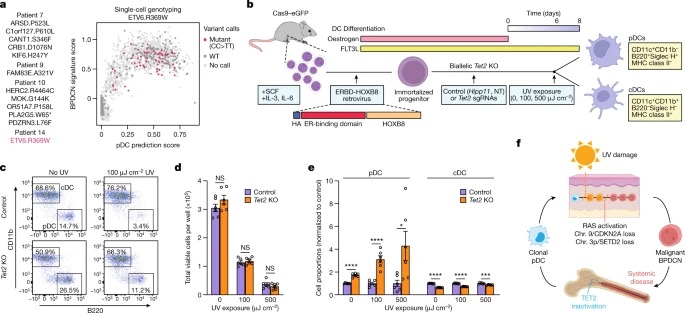자외선은 피부의 dendritic cell leukaemia transformation을 형성합니다.

Abstract
Tumours는 대부분 single anatomical niche 내에서 precursor clones의 progression으로 인해 발생합니다. bone marrow에서 clonal progenitors는 acute leukaemia로 malignant transformation를 일으키거나 peripheral tissues에서 disease pathology를 유발하는 immune cells로 분화할 수 있습니다. marrow 밖에서 이러한 clones은 잠재적으로 다양한 tissue-specific mutational processes에 노출될 수 있지만, 그 결과는 불분명합니다.
여기에서는 종종 피부에 분리된 malignant cell과 함께 나타나는 특이한 형태의 acute leukaemia인 blastic plasmacytoid dendritic cell neoplasm (BPDCN)의 발생에 대해 조사합니다. tumour phylogenomics and single-cell transcriptomics와 genotyping을 통해 BPDCN이 bone marrow의 clonal (premalignant) haematopoietic precursors에서 발생한다는 사실을 발견했습니다. 우리는 BPDCN skin tumours가 sun-exposed anatomical sites에서 처음 발생하며 ultraviolet (UV)에 의해 유도된 clonally expanded mutations로 구별되는 것을 관찰했습니다. tumour phylogenies의 reconstruction에 따르면 UV damage가 malignant transformation과 관련된 변이를 획득하기 전에 발생할 수 있으며, 이는 BPDCN pathogenesis 과정에서 plasmacytoid dendritic cells or committed precursors의 sun exposure을 암시합니다. 기능적으로, 우리는 BPDCN에서 가장 흔한 premalignant alteration인 Tet2의 loss-of-function mutations이 기존 dendritic cells는 아니지만 plasmacytoid에서 UV-induced cell death에 대한 저항성을 부여한다는 것을 발견했으며, 이는 TET2의 context-dependent tumour-suppressive role을 시사합니다. 이러한 연구 결과는 먼 해부학적 부위에서 tissue-specific environmental exposures가 premalignant clones의 disseminated cancer로의 진화를 어떻게 형성할 수 있는지를 보여줍니다.